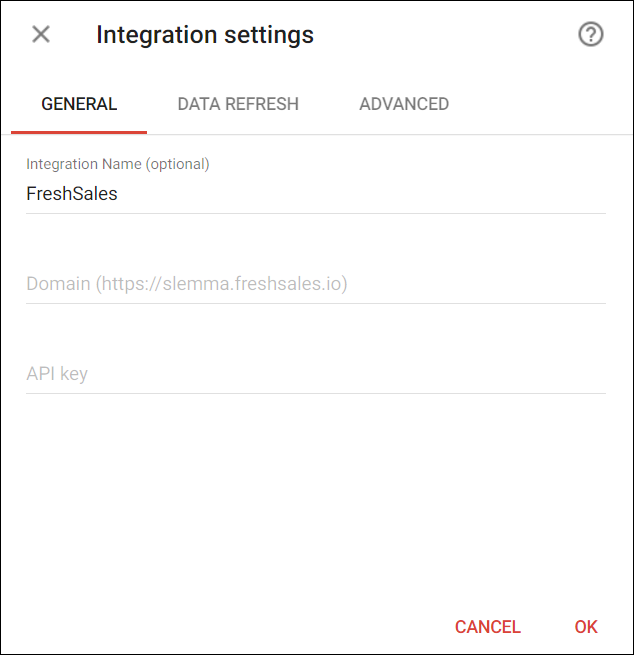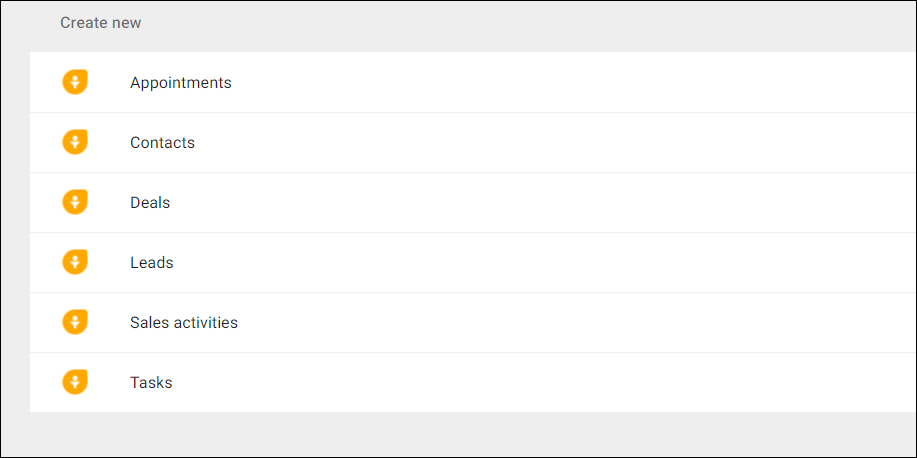From this article you can learn:
- How to integrate your Freshsales account with Slemma
- How to get data from Freshsales
- How to create a chart on the Freshsales
Creating an Integration
From your Slemma account, head over to the Library page and click the plus button at the bottom right. Select Integration from the submenu.
In the following page, you can find Freshsales with one of the following ways:
- Scroll down and select Freshsales from the list of Integrations.
- Use search to find Intercom from the list of Integrations.
- Choose Intercom using All dropdown list > CRM.
You’ll see the Integration settings dialog window. Enter your Freshsales domain and API key (here you can find the instruction on how to find your API key).

You can select the frequency for the automatic updates on the DATA REFRESH tab, or set weeks settings on the ADVANCED tab. Click OK.
After that, the integration will be created and it will appear in your account in the list of objects. Now you are able to share the integration with either individuals or the entire Team, rename or remove the integration. To view the options available for the integration, right click it in the list.
Creating a Dataset
A dataset is a collection of data in a tabular format that is created on one of the possible data sources. The datasets can be used to create dashboards or individual charts.
To create a dataset, click your Freshsales integration in the list and select Browse datasets. From the following page, select which data you want to add to use in your charts.

NOTE: Cloud Service Integrations have prebuilt datasets that are not editable.
Click dataset’s name for a description of each dataset.
This data source contains information about your leads. A lead is a prospect who has expressed interest in your product by signing up for a trial or subscribing to your newsletter etc. Dimensions + Your Custom Dimension Measures + Your Custom Measures This data source contains information about your contacts. Contacts represent the companies (Accounts) that you do business with. Dimensions + Your Custom Dimension Measures + Your Custom Measures This data source contains information about all deals. Deals are the expected sales opportunities from an account. Dimensions + Your Custom Dimension Measures + Your Custom Measures This data source contains information about your tasks. Dimensions Measures This data source contains information about your appointments. Dimensions Measures This data source contains information about all your sales activities. Sales activities are a great way to track activities related to a lead/contact/deal/account. Dimensions Measures Companies with whom you have an existing business relationship. Dimensions + Your Custom Dimension Measures + Your Custom Measures
Creating a Chart
Click a dataset or integration and select Create dashboard/Create saved chart to start building a chart.
From the next page, you can choose to create your own chart from scratch, or you can apply one of the templates we created.
- If you choose to build a new chart from scratch (“Blank” option), the Chart designer will open. Go here to learn how to create a chart in the Chart designer.
- If you choose a template, a new chart will be added to a dashboard/saved chart/presentation (depending on the way you start the chart creation).

